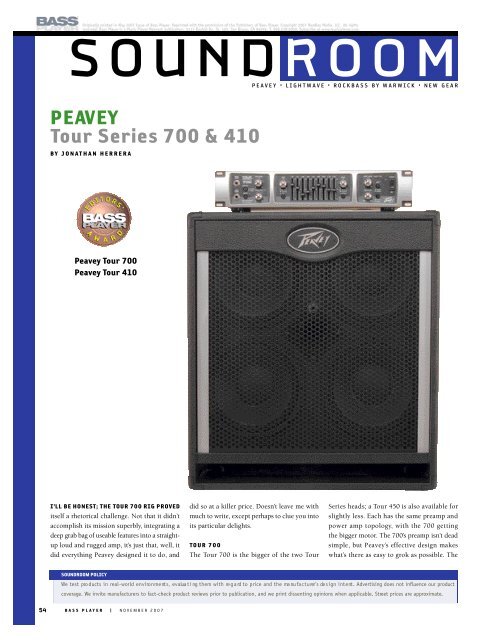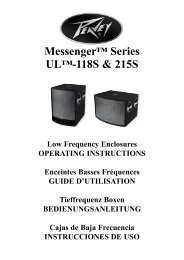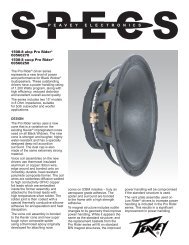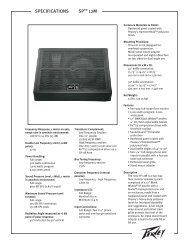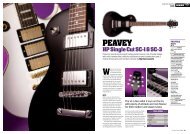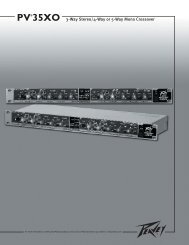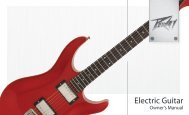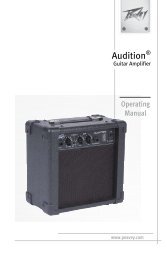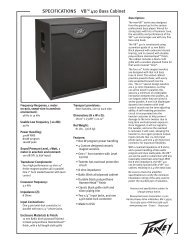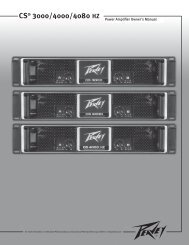sound ro om - Peavey
sound ro om - Peavey
sound ro om - Peavey
You also want an ePaper? Increase the reach of your titles
YUMPU automatically turns print PDFs into web optimized ePapers that Google loves.
S O U N D R O O M<br />
P E A V E Y • L I G H T W A V E • R O C K B A S S B Y W A R W I C K • N E W G E A R<br />
P E AV EY<br />
Tour Series 700 & 410<br />
BY J O N AT H A N H E R R E R A<br />
<strong>Peavey</strong> Tour 700<br />
<strong>Peavey</strong> Tour 410<br />
I’LL BE HONEST; THE TOUR 700 RIG PROV E D<br />
itself a rhetorical challenge. Not that it didn’t<br />
acc<strong>om</strong>plish its mission superbly, integrating a<br />
deep grab bag of useable features into a straightup<br />
loud and rugged amp, it’s just that, well, it<br />
did everything <strong>Peavey</strong> designed it to do, and<br />
did so at a killer price. Doesn’t leave me with<br />
much to write, except perhaps to clue you into<br />
its particular delights.<br />
TO U R 7 0 0<br />
The Tour 700 is the bigger of the two To u r<br />
Series heads; a Tour 450 is also available for<br />
slightly less. Each has the same preamp and<br />
power amp topology, with the 700 getting<br />
the bigger motor. The 700’s preamp isn’t dead<br />
simple, but <strong>Peavey</strong>’s effective design makes<br />
w h a t ’s there as easy to g<strong>ro</strong>k as possible. The<br />
SOUNDROOM POLICY<br />
We test p<strong>ro</strong> ducts in real-world envi<strong>ro</strong> n me nt s, evalua t i ng them with re g a rd to price and the ma nu fa c t u rer’s de s ign int e nt . Advertising does not influence our p<strong>ro</strong>duct<br />
coverage. We invite manufacturers to fact-check p<strong>ro</strong>duct reviews prior to publication, and we print dissenting opinions when applicable. Street prices are app<strong>ro</strong>ximate.<br />
54 B A S S P L A Y E R | N O V E M B E R 2 0 0 7
signal train leaves the station at one of two<br />
q" inputs, parallel H I G H or L O W G A I N j a c k s<br />
for app<strong>ro</strong>priate sensitivity with active or passive<br />
basses. The left-hand side also includes<br />
a handy B R I G H T button for a quick tre b l e<br />
boost, the all-important M U T E button, a mids<br />
c o o p i n g / b a s s - a n d - t reble boosting C O N T O U R<br />
c o n t <strong>ro</strong>l (with helpful pictogram illustrating<br />
the resulting EQ curve), and the pre a m p ’s<br />
gain knob.<br />
F <strong>ro</strong>m the input stage, the bass express hits<br />
the Tour 700’s unusually full-featured EQ section.<br />
<strong>Peavey</strong> decided to go the graphic <strong>ro</strong> u t e<br />
with its Tour Series heads, and while this is<br />
likely a turn - o ff to those who prefer simpler<br />
semi-parametric or notch-filtering designs,<br />
the 9-band circuit aff o rds exceptional power<br />
to the unafraid. Shelving filters augment the<br />
sliders on the low and high end, as does a<br />
simple L O W C U T button for quick ru m b l e<br />
reduction. I’ve conquered my fear of graphic<br />
E Q ’s (as well as my temptation to make cool<br />
wavy shapes and smiley faces), so I dug the<br />
7 0 0 ’s potent circuit. It worked well to jack up<br />
my mids for back-pickup fingerstyle or poofup<br />
the airy highs of my Audere - p re a m p -<br />
equipped Fender Jazz. Should all of this make<br />
you graphically bored, <strong>Peavey</strong> happily<br />
included an E Q B Y PA S S button, which shunts<br />
the whole scenario quick-like.<br />
Pulling into power amp station brings s<strong>om</strong>e<br />
of the Tour 700’s neatest amenities, like switchable<br />
D D T limiting and a righteously <strong>ro</strong> t u n d<br />
O C TAV E R. A red L E D indicates when the D D T c i r-<br />
cuit is putting the clamp down, but the design<br />
is so transparent, I never heard it offensively<br />
doing the kibosh. I couldn’t help but love the<br />
700 ’s O C TAV E R—maybe it’s all the synth-bass<br />
gigs I’ve been doing lately, but I’m immediately<br />
seduced by sexy Moog-ish undertones. The<br />
700’s tracked well, <st<strong>ro</strong>ng>sound</st<strong>ro</strong>ng>ed huge, and generally<br />
impressed. Plus, its ratio to the direct signal<br />
is adjustable, so it’s additionally useful as<br />
a subtle sub-harmonic boost.<br />
The 700’s construction was excellent, with<br />
a thick and rugged chassis and solidly installed<br />
c<strong>om</strong>ponents. There was nothing fancy to gawk<br />
at, just good design and construction—the sort<br />
of app<strong>ro</strong>ach that tends to last. The Class AB<br />
amp features s<strong>om</strong>ething <strong>Peavey</strong> calls “SmartRail<br />
Te c h n o l o g y,” which <strong>Peavey</strong> says imp<strong>ro</strong> v e s<br />
e fficiency by the rail voltage to best suit the<br />
input signal. In practice, the Tour 700 <st<strong>ro</strong>ng>sound</st<strong>ro</strong>ng>ed<br />
loud, even, and dynamically responsive, without<br />
any notable humps or frumps in the frequency<br />
spectrum.<br />
Continued<br />
P E AV EY TO U R 7 0 0<br />
List $699<br />
Street $559<br />
P<strong>ro</strong>s St<strong>ro</strong>ng, loud, straightforward <st<strong>ro</strong>ng>sound</st<strong>ro</strong>ng> with a<br />
killer octave circuit<br />
Cons Graphic EQ might freak out s<strong>om</strong>e of y’all<br />
Bott<strong>om</strong> Line A super-solid head for loud gigs<br />
on a tight budget<br />
P E AV EY TO U R 4 1 0<br />
List $799<br />
Street $599<br />
P<strong>ro</strong>s Great power handling with sweet mids<br />
Cons A touch harsh on the top<br />
Bott<strong>om</strong> Line Lightweight big volume at a low<br />
price<br />
CO N TAC T<br />
601-483-5365<br />
www.peavey.c<strong>om</strong><br />
T EC H S P ECS<br />
TO U R 700 HEAD<br />
Power rating 500 watts RMS into 8Ω; 700 watts<br />
RMS into 4Ω minimum load<br />
Tone cont<strong>ro</strong>ls LOW: ±15dB @ 50Hz; GRAPHIC EQ:<br />
±15dB @ 40Hz, 63Hz, 100Hz, 160Hz, 250 Hz,<br />
400Hz, 800Hz, 1.6kHz, 3.2kHz; HIGH: ±15dB @<br />
5kHz<br />
Additional tone cont<strong>ro</strong>ls LOW CUT: preset cut @<br />
80Hz; CONTOUR: midrange cut and bass and treble<br />
boost, variable; BRIGHT: +10dB @ 10kHz<br />
XLR DIRECT INTERFACE output Differential op-amp<br />
driven with GROUND LIFT switch<br />
Power amp topology Class AB<br />
Weight 23 lbs<br />
Made in China<br />
Warranty Five years limited<br />
N O V E M B E R 2 0 0 7 | B A S S P L A Y E R<br />
55
The Tour 700 uses my all-time favorite jack: the<br />
Neutrik C<strong>om</strong>bo, which allows use with q" or<br />
Speakon cables. Industry, say it with me: We<br />
will put these on all our amps.<br />
T EC H S P ECS<br />
TO U R 410 4x10 CABI N E T<br />
Type 4x10 + tweeter, ported<br />
Frequency response 41Hz–15kHz<br />
Power handling 1,600 watts RMS<br />
Impedance 8Ω<br />
Sensitivity 100dB SPL (1W/1M)<br />
Speakers 10" <strong>Peavey</strong> cust<strong>om</strong>-designed<br />
neodymium<br />
Weight 65 lbs<br />
Made in U.S.A<br />
Warranty Five years limited<br />
TO U R 4 10<br />
With the arrival of <strong>Peavey</strong>’s To u r-series cabs,<br />
neodymium has gone fully mainstream. The<br />
lightweight magnet material, which was previously<br />
the purvey of elite where - t h e - h e l l -<br />
do-I-buy-that brands, is now available for a<br />
song, and <strong>Peavey</strong> nailed it. The 410 was light,<br />
loud, and quick, with a st<strong>ro</strong>ng and buoyant<br />
midrange, a delicate—but present—low end,<br />
and a treble extension that is a bit unre f i n e d<br />
f <strong>ro</strong>m the tweeter, especially considering the<br />
woofers’ smooth response ac<strong>ro</strong>ss the frequency<br />
spectrum. The slot-ported cabinet<br />
seemed st<strong>ro</strong>ng and was well braced. The cab<br />
pairs well with the 700, but I could also see<br />
it being an ideal entry-level option for those<br />
inclined to have a big multi-driver cab, curious<br />
about the neo thing, and interested in<br />
saving a bit of dough.<br />
I gave it a go with this re v i e w, but ultimately<br />
the <strong>Peavey</strong> just got the job done, leaving it difficult<br />
for me to get m y job done. At this price<br />
range, the market g<strong>ro</strong>ws ever thicker with phen<strong>om</strong>enal<br />
deals, but <strong>Peavey</strong> laid it down with<br />
the Tour Series. They’re loud, light, and sweet<br />
<st<strong>ro</strong>ng>sound</st<strong>ro</strong>ng>ing. These are good things.<br />
BP


